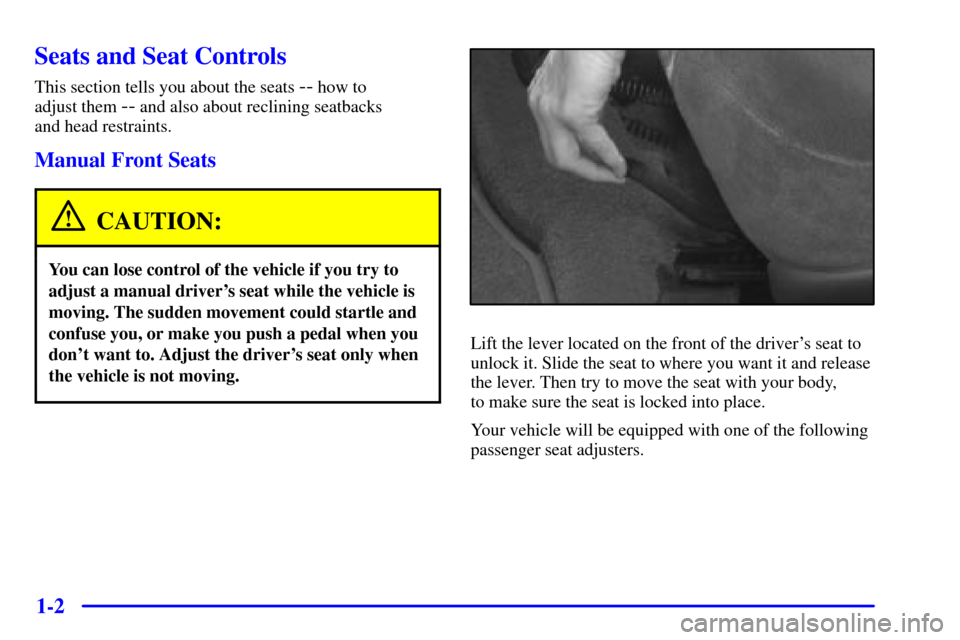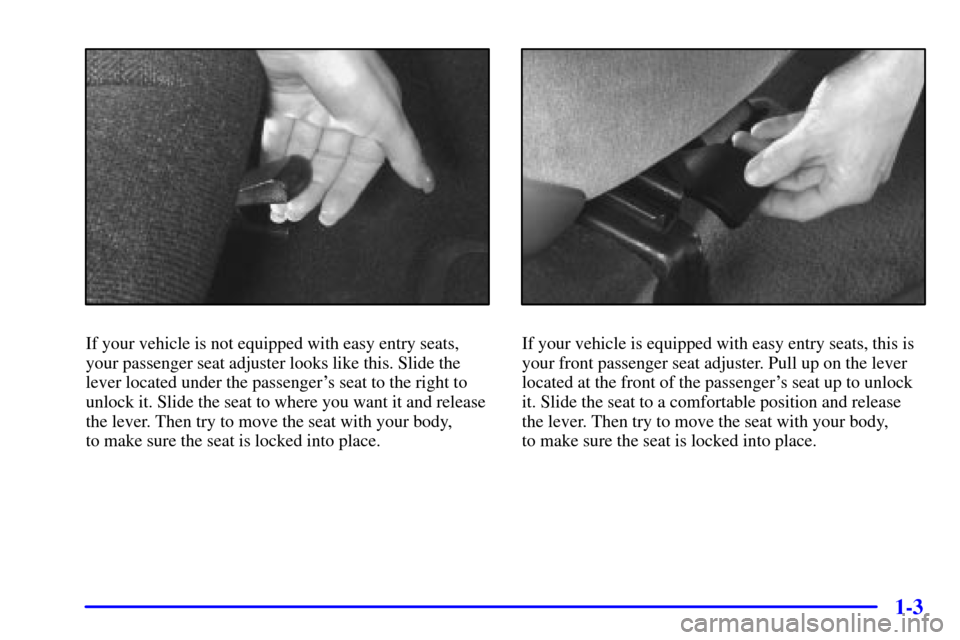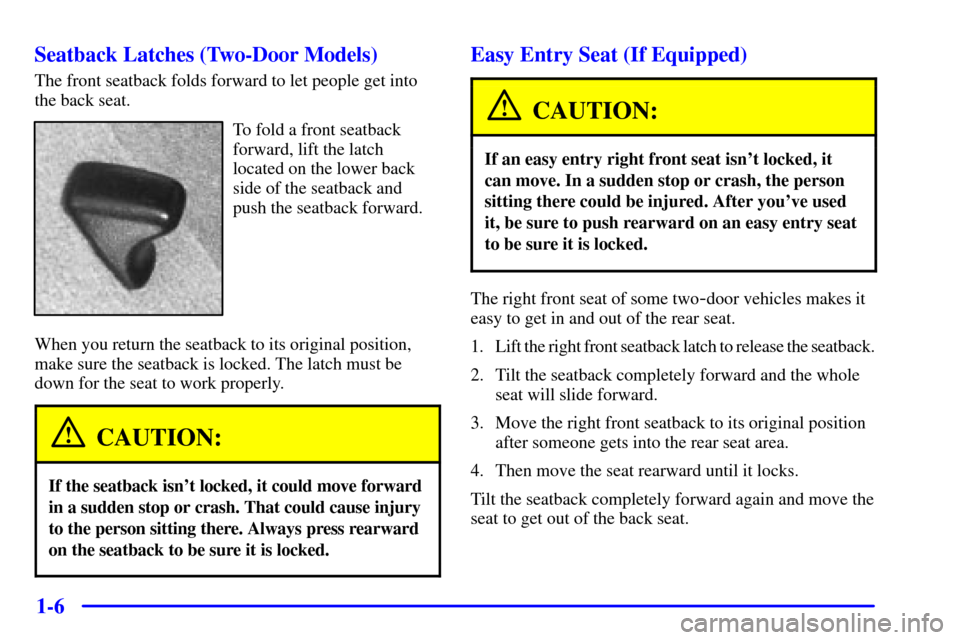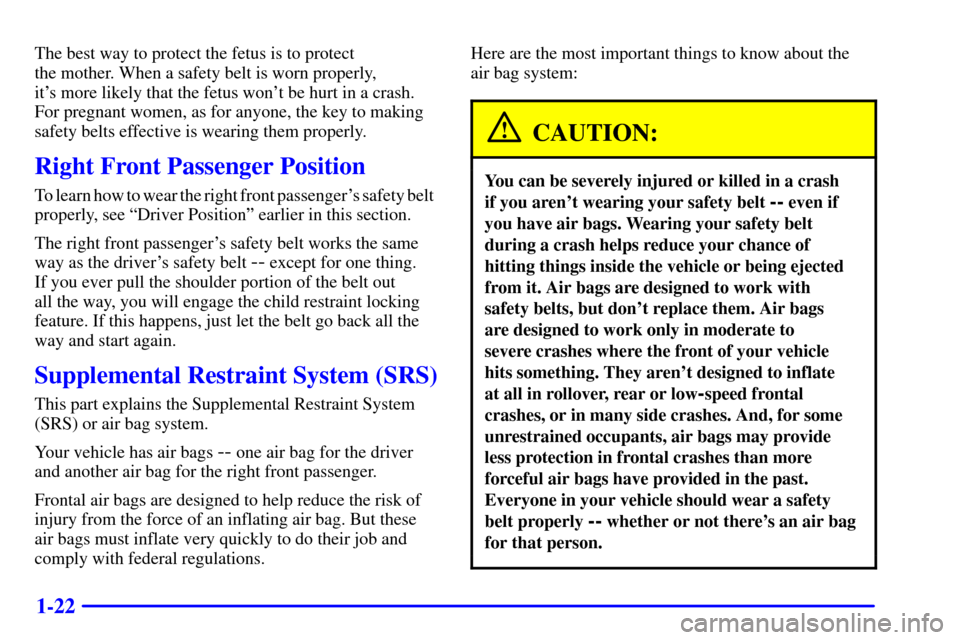lock CHEVROLET CAVALIER 2002 3.G Owners Manual
[x] Cancel search | Manufacturer: CHEVROLET, Model Year: 2002, Model line: CAVALIER, Model: CHEVROLET CAVALIER 2002 3.GPages: 360, PDF Size: 2.46 MB
Page 8 of 360

1-2
Seats and Seat Controls
This section tells you about the seats -- how to
adjust them
-- and also about reclining seatbacks
and head restraints.
Manual Front Seats
CAUTION:
You can lose control of the vehicle if you try to
adjust a manual driver's seat while the vehicle is
moving. The sudden movement could startle and
confuse you, or make you push a pedal when you
don't want to. Adjust the driver's seat only when
the vehicle is not moving.
Lift the lever located on the front of the driver's seat to
unlock it. Slide the seat to where you want it and release
the lever. Then try to move the seat with your body,
to make sure the seat is locked into place.
Your vehicle will be equipped with one of the following
passenger seat adjusters.
Page 9 of 360

1-3
If your vehicle is not equipped with easy entry seats,
your passenger seat adjuster looks like this. Slide the
lever located under the passenger's seat to the right to
unlock it. Slide the seat to where you want it and release
the lever. Then try to move the seat with your body,
to make sure the seat is locked into place.If your vehicle is equipped with easy entry seats, this is
your front passenger seat adjuster. Pull up on the lever
located at the front of the passenger's seat up to unlock
it. Slide the seat to a comfortable position and release
the lever. Then try to move the seat with your body,
to make sure the seat is locked into place.
Page 10 of 360

1-4 Reclining Front Seatbacks
To adjust the seatback, lift the lever located on the
outboard side of the seat and move the seatback to
where you want it. Release the lever and push rearward
on the seatback to make sure it is locked. Pull up on the
lever without pushing on the seatback and the seatback
will go to an upright position.But don't have a seatback reclined if your vehicle
is moving.
Page 12 of 360

1-6 Seatback Latches (Two-Door Models)
The front seatback folds forward to let people get into
the back seat.
To fold a front seatback
forward, lift the latch
located on the lower back
side of the seatback and
push the seatback forward.
When you return the seatback to its original position,
make sure the seatback is locked. The latch must be
down for the seat to work properly.
CAUTION:
If the seatback isn't locked, it could move forward
in a sudden stop or crash. That could cause injury
to the person sitting there. Always press rearward
on the seatback to be sure it is locked.
Easy Entry Seat (If Equipped)
CAUTION:
If an easy entry right front seat isn't locked, it
can move. In a sudden stop or crash, the person
sitting there could be injured. After you've used
it, be sure to push rearward on an easy entry seat
to be sure it is locked.
The right front seat of some two-door vehicles makes it
easy to get in and out of the rear seat.
1. Lift the right front seatback latch to release the seatback.
2. Tilt the seatback completely forward and the whole
seat will slide forward.
3. Move the right front seatback to its original position
after someone gets into the rear seat area.
4. Then move the seat rearward until it locks.
Tilt the seatback completely forward again and move the
seat to get out of the back seat.
Page 20 of 360

1-14 Lap-Shoulder Belt
The driver has a lap-shoulder belt. Here's how to
wear it properly.
1. Close and lock the door.
2. Adjust the seat so you can sit up straight.
To see how, see ªSeatsº in the Index.
3. Pick up the latch plate and pull the belt across you.
Don't let it get twisted.
The shoulder belt may lock if you pull the belt across
you very quickly. If this happens, let the belt go back
slightly to unlock it. Then pull the belt across you
more slowly.
4. Push the latch plate into the buckle until it clicks.
Pull up on the latch plate to make sure it is secure.
If the belt isn't long enough, see ªSafety Belt
Extenderº at the end of this section.
Make sure the release button on the buckle is
positioned so you would be able to unbuckle the
safety belt quickly if you ever had to.
Page 21 of 360

1-15
5. To make the lap part tight, pull down on the buckle
end of the belt as you pull up on the shoulder belt.The lap part of the belt should be worn low and snug on
the hips, just touching the thighs. In a crash, this applies
force to the strong pelvic bones. And you'd be less likely
to slide under the lap belt. If you slid under it, the belt
would apply force at your abdomen. This could cause
serious or even fatal injuries. The shoulder belt should
go over the shoulder and across the chest. These parts
of the body are best able to take belt restraining forces.
The safety belt locks if there's a sudden stop or crash,
or if you pull the belt very quickly out of the retractor.
Page 22 of 360

1-16
Shoulder Belt Height Adjuster (Four-Door Models)
Before you begin to drive, move the shoulder belt
adjuster to the height that is right for you.To move it down, squeeze the release button and move
the height adjuster to the desired position. You can move
the adjuster up just by pushing up on the shoulder belt
guide. After you move the adjuster to where you want it,
try to move it down without squeezing the release button
to make sure it has locked into position.
Adjust the height so that the shoulder portion of the
belt is centered on your shoulder. The belt should be
away from your face and neck, but not falling off
your shoulder.
Page 28 of 360

1-22
The best way to protect the fetus is to protect
the mother. When a safety belt is worn properly,
it's more likely that the fetus won't be hurt in a crash.
For pregnant women, as for anyone, the key to making
safety belts effective is wearing them properly.
Right Front Passenger Position
To learn how to wear the right front passenger's safety belt
properly, see ªDriver Positionº earlier in this section.
The right front passenger's safety belt works the same
way as the driver's safety belt
-- except for one thing.
If you ever pull the shoulder portion of the belt out
all the way, you will engage the child restraint locking
feature. If this happens, just let the belt go back all the
way and start again.
Supplemental Restraint System (SRS)
This part explains the Supplemental Restraint System
(SRS) or air bag system.
Your vehicle has air bags
-- one air bag for the driver
and another air bag for the right front passenger.
Frontal air bags are designed to help reduce the risk of
injury from the force of an inflating air bag. But these
air bags must inflate very quickly to do their job and
comply with federal regulations.Here are the most important things to know about the
air bag system:
CAUTION:
You can be severely injured or killed in a crash
if you aren't wearing your safety belt
-- even if
you have air bags. Wearing your safety belt
during a crash helps reduce your chance of
hitting things inside the vehicle or being ejected
from it. Air bags are designed to work with
safety belts, but don't replace them. Air bags
are designed to work only in moderate to
severe crashes where the front of your vehicle
hits something. They aren't designed to inflate
at all in rollover, rear or low
-speed frontal
crashes, or in many side crashes. And, for some
unrestrained occupants, air bags may provide
less protection in frontal crashes than more
forceful air bags have provided in the past.
Everyone in your vehicle should wear a safety
belt properly
-- whether or not there's an air bag
for that person.
Page 35 of 360

1-29
Lap-Shoulder Belt
The positions next to the windows have lap
-shoulder
belts. Here's how to wear one properly.
1. Pick up the latch plate and pull the belt across you.
Don't let it get twisted.
The shoulder belt may lock if you pull the belt across
you very quickly. If this happens, let the belt go back
slightly to unlock it. Then pull the belt across you
more slowly.2. Push the latch plate into the buckle until it clicks.
If the belt stops before it reaches the buckle, tilt the
latch plate and keep pulling until you can buckle it.
Pull up on the latch plate to make sure it is secure.
If the belt is not long enough, see ªSafety Belt
Extenderº at the end of this section. Make sure the
release button on the buckle is positioned so you
would be able to unbuckle the safety belt quickly
if you ever had to.
Page 37 of 360

1-31
The safety belt locks if there's a sudden stop or a crash,
or if you pull the belt very quickly out of the retractor.
CAUTION:
You can be seriously hurt if your shoulder belt is
too loose. In a crash, you would move forward too
much, which could increase injury. The shoulder
belt should fit against your body.
To unlatch the belt, just push the button on the buckle.